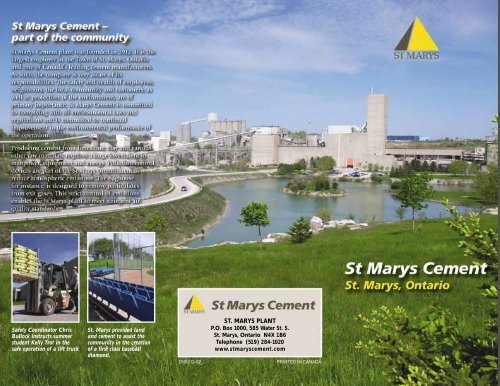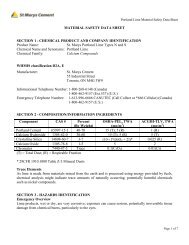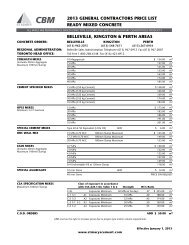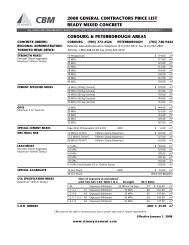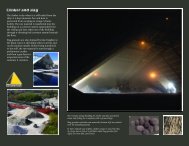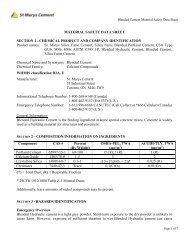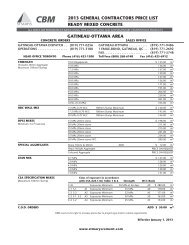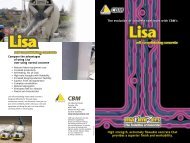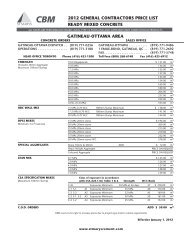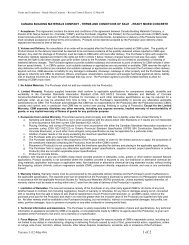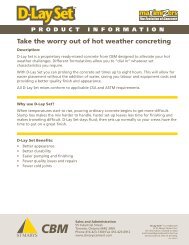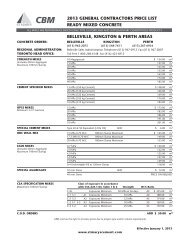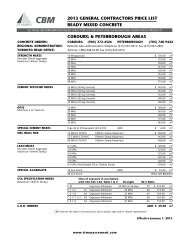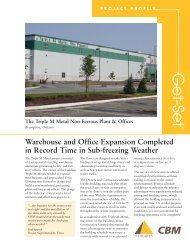St. Marys Plant Brochure - St Marys Cement
St. Marys Plant Brochure - St Marys Cement
St. Marys Plant Brochure - St Marys Cement
You also want an ePaper? Increase the reach of your titles
YUMPU automatically turns print PDFs into web optimized ePapers that Google loves.
Safety Coordinator Chris<br />
Bullock instructs summer<br />
student Kelly Trot in the<br />
safe operation of a lift truck<br />
<strong>St</strong>. <strong>Marys</strong> provided land<br />
and cement to assist the<br />
community in the creation<br />
of a first class baseball<br />
diamond.<br />
ST. MARYS PLANT<br />
P.O. Box 1000, 585 Water <strong>St</strong>. S.<br />
<strong>St</strong>. <strong>Marys</strong>, Ontario N4X 1B6<br />
Telephone (519) 284-1020<br />
www.stmaryscement.com<br />
2500/12-02 PRINTED IN CANADA
For its raw materials, cement uses minerals containing<br />
four essential elements: calcium, silicon, aluminum<br />
and iron. The <strong>St</strong> <strong>Marys</strong> <strong>Cement</strong> plant relies on a<br />
quarry located nearly a kilometre west of the plant for<br />
limestone, which is the calcium component and the<br />
primary ingredient of cement. This is coupled with<br />
smaller quantities of clay, mined from another<br />
location east of the plant, and sand. These are sources<br />
of silica, aluminum, and iron. Other raw materials,<br />
such as shale, bauxite and fly ash are trucked in as<br />
necessary. Generally, the extraction of the raw<br />
materials required to produce cement causes less<br />
damage to the environment than the production of<br />
comparable building materials and ultimately,<br />
quarries can be reclaimed for agricultural, recreational<br />
or commercial development.<br />
RAW MATERIAL<br />
After limestone is blasted from the face of the quarry,<br />
trucks haul the shot rock to the primary crusher. This<br />
raw feed is then transferred across the Thames River<br />
by conveyor to a stockpile where the secondary<br />
crusher further reduces the material in size. It is then<br />
conveyed to the 2,200 tonne storage silo at the plant.<br />
Clay is hauled to the plant by truck where it is dried<br />
before being stored in two additional storage silos.<br />
Loader operator, Larry Foreman stands beside his Cat 990 to<br />
demonstrate the scale of the equipment required to lift shot<br />
rock from the quarry floor.<br />
Hardworking 40 tonne quarry trucks transfer shot rock<br />
from the face to the primary crusher within the quarry.<br />
An extensive conveyor system moves raw material from<br />
the primary crusher in the quarry to the stockpile near<br />
the plant.<br />
A drilling rig is used to bore holes into the limestone.<br />
Explosives are then placed and the blast detonated from<br />
the other side of the quarry.
The 72 metre high preheater tower supports two<br />
bucket elevators which lift the meal to the top. To<br />
save valuable energy, hot exit gases from the kiln heat<br />
the raw meal in a series of vertical cyclone chambers<br />
through which the meal passes on the way to the kiln.<br />
KILN<br />
The 75 metre long kiln is a huge rotating furnace – a<br />
horizontally sloped steel cylinder, 4.75 metres in<br />
diameter, lined with firebrick and turning about two<br />
revolutions per minute. The raw meal enters the kiln<br />
at the upper end as a powder. It slides and tumbles<br />
down the kiln through progressively hotter zones. At<br />
the lower end of the kiln, fuel (powdered coal, coke<br />
or natural gas) feeds a flame that reaches 1870°C –<br />
one-third the temperature of the sun’s surface. Here in<br />
the hottest part of the kiln, the raw materials reach<br />
about 1480°C and become partially molten. This<br />
intense heat triggers chemical and physical changes.<br />
A series of chemical reactions converts the calcium<br />
and silicon oxides into calcium silicates, cement’s<br />
main component. At the lowest end of the kiln, the<br />
raw materials emerge as a new substance called<br />
clinker.<br />
The 75m long kiln rotates twice a minute as the raw material<br />
rolls and slides along its length.<br />
Using a mixture of coal and coke mixed with air for fuel,<br />
cement kiln temperatures reach 1870°C causing a chemical<br />
change in the raw material.<br />
Coal and coke are stored in the yard until required as fuel.<br />
The four stage preheater tower uses waste heat from the kiln<br />
to raise the temperature of the raw meal and reduces the<br />
energy required to produce the clinker.
The limestone and clay must first be analyzed and<br />
blended in the proper proportion. Using the plant’s<br />
roller mill, the material is ground even to the<br />
consistency of sand. The resulting raw meal and the<br />
recycled kiln gases used to dry it, pass through a bag<br />
house where particulates are removed before the<br />
gases are exhausted into the atmosphere. The<br />
material then drops into one of two homogenizing<br />
silos below, where it is blended before overflowing<br />
into the kiln feed silo.<br />
THE AUTOMATED PROCESS<br />
Skilled operators constantly monitor the operation<br />
of the plant from the control room. Temperatures,<br />
flow rates, pressures and the chemical composition<br />
of the raw meal are just some of the variables which<br />
may effect the quality of the final product. Although<br />
145 people are required to operate the <strong>St</strong>. <strong>Marys</strong><br />
plant, it is still fully automated and computer<br />
controlled. This room is the flight deck of one of<br />
the largest pieces of moving machinery in the world<br />
. . . a modern cement kiln.<br />
Gary Smale watches the roughly two-to-one mixture of<br />
limestone and clay on its way from the raw mill.<br />
A Cat 375 backhoe digs deep into a pile of silica, one<br />
of the raw materials required to chemically balance the<br />
manufacture of Portland cement.<br />
Glen Watkinson is one of the kiln operators responsible for<br />
overseeing the computer controlled functions of the plant.<br />
The roller mill uses recycled kiln gases for drying the limestone<br />
and clay during this stage of the grinding process.
After being cooled, the clinker is again crushed before<br />
being discharged onto a conveyor. To save energy, heat<br />
recovered from the cooling process is recirculated back<br />
to the kiln. The clinker, is transferred on the conveyor<br />
to the 45,000 tonne A-frame storage hall.<br />
FINISH MILLING<br />
The clinker is next ground in one of five ball mills –<br />
huge rotating, horizontal steel cylinders containing<br />
steel alloy balls in one or two chambers. The clinker,<br />
along with other materials added to impart special<br />
characteristics to the finished product, is ground into<br />
powder so fine it will pass through a sieve that could<br />
hold water. Up to 5% gypsum, to regulate the setting<br />
time of the cement plus other chemicals, such as those<br />
which regulate flowability or air entrainment, are<br />
added at this stage.<br />
A state-of-the-art lab is used to analyze the raw material, maintain<br />
quality control and formulate special products. Lab Technician,<br />
Mike <strong>St</strong>anzel begins fusing cement samples before x-ray analysis.<br />
The A-frame storage building is used for the storage of<br />
clinker until it can be ground.<br />
Clinker, still cooling on the conveyor, fresh from the kiln.<br />
Ball mills (five all together) are essentially steel tubes which contain various sized steel balls. As the mills rotate, the clinker is crushed<br />
into a fine powder.
From the grinding mills, the finished Portland cement<br />
is conveyed to silos where it awaits bagging or bulk<br />
shipment. All of the bulk cement is moved by tanker<br />
truck or rail from the <strong>St</strong> <strong>Marys</strong> plant. A small<br />
percentage is bagged for specialized purposes such as<br />
masonry mortar. Flatbed trucks stacked with bags on<br />
skids and tanker trucks and rail cars containing<br />
cement in bulk are constantly leaving the plant.<br />
The <strong>St</strong>. <strong>Marys</strong> plant has 90,000 tonnes of cement storage while production capacity is more than seven times that amount.<br />
Pallets of bagged product are loaded onto a Hutton Transport<br />
truck being tied down by driver Craig Paton.<br />
Gate No. 1 at the <strong>St</strong>. <strong>Marys</strong> <strong>Plant</strong> <strong>St</strong> <strong>Marys</strong> <strong>Cement</strong> is transported in bulk by truck and rail. Masonry and mortar cements of various types are the common<br />
bagged product packaged at the <strong>St</strong>. <strong>Marys</strong> <strong>Plant</strong>.


